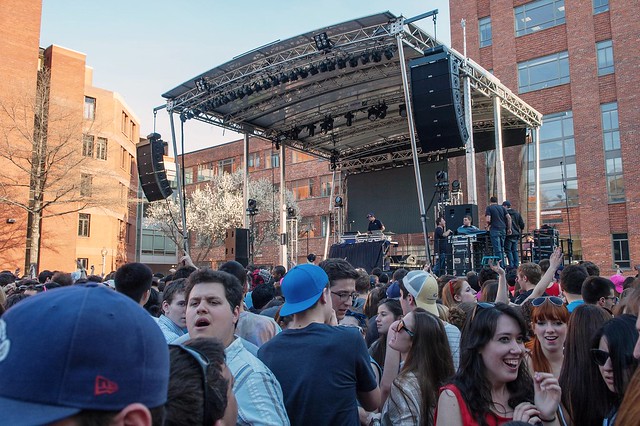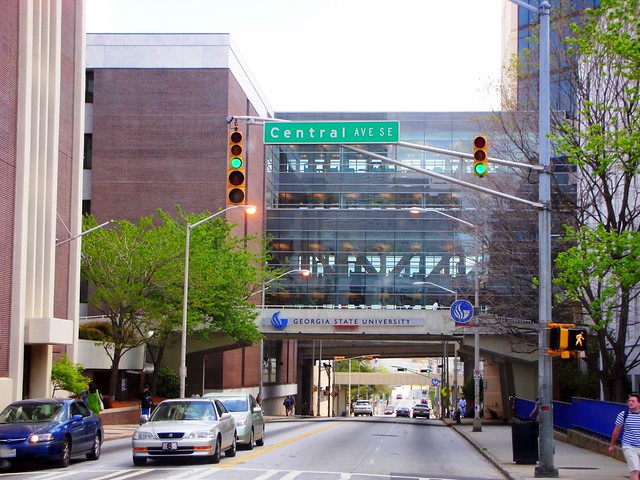How reinventing university-city relationships can boost communities' sustainability (guest post by Lee Epstein)

Posted May 12, 2014 at 1:30PM
Nearly from time immemorial, a scholar’s relationship with the place where his or her learning occurred was a fraught thing. From the Middle Ages when universities were invented, the recipe inherently made it so: take a young person, plop him (at the time it was only “hims”) down in a “foreign” setting without direct familial constraints but with new peer pressures, add in a pinch (or more) of academic pressure, a generous cup of privilege, and more than a smidgeon of mutual class animosity and misunderstanding, blend with local economic conditions, different cultures and traditions of the community-at-large, and you end up with a situation that sometimes doesn’t make for a happy fusion.
In 1355, the “Battle of St. Scholastica” raged for two days as townsfolk attacked, injured, and even killed students and scholars at the University of Oxford in England after a fight in a tavern got out of hand. It’s now 2014 and, while we are thankfully past an era like that one, there is still heartbreak in college towns: multiple instances of drunken underage fraternity members tragically falling to their deaths (for example, one young man fell out of a third-floor window at Northwestern University in 2013), or students being the subjects of violent crime by locals (for example, at the University of Southern California in 2012, and the University of Maryland in 2013) illustrate serious problems – where town and college must come together over solutions.
Challenges facing universities and host cities
The issues surrounding university/host-city relationships in more modern times include such matters of interpersonal interaction but are today, of course, much broader, reaching institutional and community development issues. These include the difficult problems of the non-taxability of sometimes extensive university property; rent and housing affordability for the community-at-large, as affected by student housing pressures and/or the presence of a significant cohort of well-compensated staff; overall community economic development; how university payrolls impact those of other institutions and businesses in the city; the urban design and potential “green modeling” of campuses; and importantly, immediate neighborhood impacts -- the attractiveness to colleges of absorbing ever-larger chunks of the communities in which they reside. These issues all ultimately affect the sustainability of universities’ hometowns in both positive and negative ways.
Modern universities help define and lend cachet to the cities in which many reside, but that hasn’t made town-gown relationships any easier to maintain. From the “Ivies” in Cambridge, Massachusetts (Harvard and MIT) and Palo Alto, California (Stanford), to excellent liberal arts colleges in small towns everywhere (like Bucknell University in Lewisburg, and Lehigh University in Bethlehem, both in Pennsylvania), and good state universities (such as the University of Wisconsin in Madison and the University of Arizona in Tucson) there is a strong degree of co-dependency that city and university alike have sometimes been late to admit. Such relationships directly affect sustainability and livability in these communities.
It has not always been pretty. Power, prestige, and frankly, money can lead to at least the perception if not the reality of bullying and city “takeovers” by university leadership. While I attended graduate and law school at the George Washington University (GW) in the late 1970s, a standing joke was that it was the only real estate company in Washington, DC that also happened to offer university degrees. College expansion plans often rankle local politicians and residents alike, as they perceive unfair competition for tax-ratable property and watch, sometimes hopelessly outgunned, as their intimate residential or close-knit commercial neighborhoods are gobbled up by the giant next-door.
The late 20th century may have marked the pinnacle (or nadir, depending upon your perspective) of this kind of activity. GW was taking over whole blocks of row houses and beginning to build large academic clusters. At the same time, it was redeveloping sectors of downtown Washington, DC real estate into substantial for-profit leasing ventures. Johns Hopkins’s huge and prestigious medical campus was expanding by leaps and bounds into surrounding Baltimore neighborhoods. So was Yale in New Haven, and the list goes on, from the largest and most well-heeled institutions to small colleges in more isolated college towns.
Positive outcomes for communities
At the same time, there is no doubt that many universities have a positive economic impact in the place where they reside. Indeed, colleges today rightfully tout the strong economic enhancement that they have brought to their hometowns. Yale is New Haven’s largest employer, with some 12,000 full-time employees, 4,000 of whom live in the city and contribute to its tax base. Hopkins is the largest private employer in Baltimore, employing more than 33,000; their purchases of goods and services in the city exceeded $387 million in 2010, and the hospital and medical school delivered $65 million in uncompensated health care to city residents that year. Schools have even voluntarily begun paying property taxes; Yale paid $8 million in 2012. (And on non-academic property that they redevelop and lease out, these schools regularly pay taxes.
Fortunately, universities are much more active today than a decade or two ago in how they interact with their communities, extending social services, as well as educational and cultural resources. Large institutions, such as the University of Southern California, have extensive civic or community engagement programs that include providing housing purchase assistance to qualifying employees within the University’s nearby neighborhoods (thus not only helping to stabilize them but also allowing for either transit- or walk/bike-commutes); providing local economic development and community design assistance; and, through their hospital and health system resources, offering assets to the underserved like mobile asthma and mobile dental clinics.
Some smaller liberal arts colleges, such as Bucknell, have also started providing community services, such as free consulting to local small businesses, social asset audits for nearby towns, and environmental work on the adjacent Susquehanna River. Bucknell has even been adding to the small town of Lewisburg’s economic strengths.
For example, Bucknell and Lewisburg cooperated over the last decade to facilitate a renovation of three historic downtown buildings: creating (with Barnes and Noble) a sizable University bookstore that helps draw students and faculty downtown; undertaking the full restoration of a beautiful, historic downtown movie theater for the public and students alike; and converting a (former) multi-story US post office into university offices. (With luck, the bookstore will survive other such stores’ recent corporate slim-downs, and also won’t out-compete the small independent bookstore still in town.)
Though they might think so, universities are not, just by their very presence, always of wonderful benefit to their host communities. Many of the most difficult issues discussed above relate to the often uneven expression of power and money. Further complicating the relationship in both positive and negative ways are such other matters as:
- the effectiveness and completeness of a campus’s physical linkages to the community-at-large;
- transportation facilities, including the college’s transit system, correspondence with municipal transit, and the walkability of the campus;
- the overall urban design and inclusion of usable open space, both hardscape and green space, where the public is invited in;
- ever-expanding sports complexes, the ground they gobble up, and the regular, often disruptive intrusion of traffic they may bring;
- requests for street vacations as university facilities expand;
- and of course all the other components of physical plant and design that can help make an institution “green” and a model for the community in which it resides (such as best contemporary stormwater management, the use of non-polluting fleet vehicles, waste management and recycling, and low energy and water usage or self-generation) – or, on the other hand, may simply make it just another big and mostly unhelpful “gray” neighbor producing polluted runoff and other environmental impacts.
Working together to address common issues
The key, it seems, is the degree to which the modern university understands that it does have a significant role to play within the community – a role that is larger than just educating its own students (many or the majority of whom may be from outside the community). As a leading corporate citizen, that role when expressed well involves helping the city to develop and redevelop in a sustainable way, so that college expansion doesn’t always mean urban displacement or unmitigated gentrification, and facility development doesn’t just mean more big concrete boxes without reference to place and without reducing the environmental impact of their footprint. The role surely involves making the physical campus an integral part of the community, and allowing some of its resources – campus space, funds, expertise, and specialized focus -- to be used to enhance the community’s social, economic, and environmental well-being. It also should mean modeling excellent environmental behavior, so as to provide an area-wide exemplar to corporate citizens and the public sector alike.
On the town’s part, the relationship involves fully welcoming the university as an urban planning and community development partner, integrating transportation systems and other infrastructure as much as possible, and linking its own and the university’s public safety concerns. Host communities should be willing to allow and invite college students and faculty to help them as they wrestle with contemporary social and economic problems, education issues, and public health. Indeed, as Richard Florida noted in a March 24, 2014 Atlantic Cities article, “The US Cities Where the Poor Are Most Segregated from Everyone Else,” many college towns have significant issues with concentrated poverty:
“When medium and smaller-sized metros are taken into account, many of the places with the most concentrated poverty turn out to be college towns, where the town-gown divide seems to be very real. State College, Pennsylvania (home to Penn State), has the highest level of poverty segregation in the country; Ann Arbor (University of Michigan) is fifth; Ames, Iowa (Iowa State) is eighth and New Haven (Yale University) is tenth. Madison, Wisconsin (University of Wisconsin); Boulder, Colorado (University of Colorado); Iowa City, Iowa (University of Iowa); and Champaign-Urbana, Illinois (University of Illinois), all suffer from relatively high levels of poverty segregation as well.”
According to the study Florida cites, the segregation of poverty in these metro areas is (somewhat surprisingly) positively correlated with overall average wages, per capita incomes, economic output per capita, percent of adults that are college graduates, and other indicators of a knowledge-based economy. While it is obvious one would find these attributes in university towns, it is not immediately clear what the solutions might be other than more open and inviting employment policies, and the social outreach and assistance noted above. Town and gown surely should work on these issues together as partners toward a more inclusive and equitable community.
It’s not 1355 anymore. There are some 4,000 public and private four-year and two-year colleges and universities in the US. There is surely mutual benefit to be realized, if only those several thousand communities and their institutions of higher learning understand that, and work hard to make it happen. From what I can see – at least from the proverbial 10,000 feet up – there is now a lot more of that cooperation and coordination than ever before. And that can only redound to the ultimate benefit of both town and gown.
Move your cursor over the images for credit information.
Lee Epstein is an attorney and land use planner working for sustainability in the mid-Atlantic region, and a frequent contributor to this blog.
Related posts:
- Emory University's impressive commitment to sustainability (April 4, 2011)
- Will the real green colleges please stand up? (by Lee Epstein) (March 21, 2012)
- Madness: the NCAA Sweet Sixteen decided by Walk Score! (March 20, 2012)



